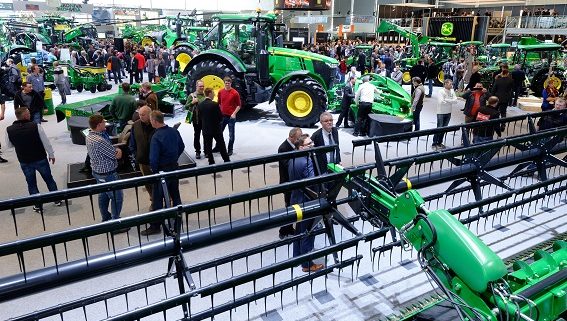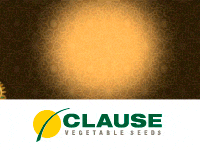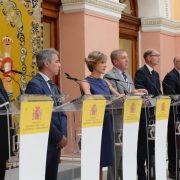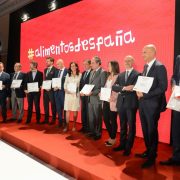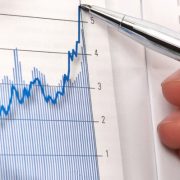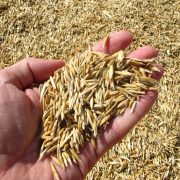Agritechnica 2017 faces Agriculture 4.0 from a global perspective
By M. Betancort
It is not only about reducing emissions, the path of digitalization towards agriculture 4.0 (two steps beyond the “precision farming” and that the “Smart farming”) goes towards a more global approach, which seeks the reduction of the footprint of carbon.
The agriculture of the future has long since left the bucolic image of the poppy field and is now closer to our smartphone. Agritechnica 2017, the world’s leading German fair will present in its next edition (which will take place from November 12th to 18th, 2017 in Hannover) all the novelties for the agricultural business, which have more to do with connectivity and intelligent processing of the information than with the task itself. It is about making work in the field more efficient, all managed from tablets and smartphones, connecting machines to databases, public or private, with historical and recommendations on automatic adjustments in the equipment, to make them more effective. So agriculture can be more productive and more sustainable.
“Green future-Smart technology” is the title under which the next edition of the fair is framed. We expected new developments in the electronics and automation environment, but the summary of what is presented is that one more step is taken and we are already talking about Digital Agriculture with capital letters.
“The trend is towards greater process automation, connected with intelligent data management systems to optimize the regulation and control of machines, their logistics, documentation and traceability. That’s why we talk about Agriculture 4.0 “, says Dr. Reinhard Grandke, managing director of the DLG, organizer of Agritechnica.
The focus is now “holistic”, not just focused on reducing emissions. It is about taking into account the total carbon footprint that the machine leaves, from its design to its production and operation, not just pure direct emissions.
It is more logical to organize production and distribution so that it is not necessary to transport the machine from the opposite end of the planet, than to spend millions on R & D so that its engine emits less
In this sense, the role of digital technology in the organization of agricultural work is important, so that it is more efficient and respects the environment more, with an optimization of inputs and a better care of the soil.
According to professor Hans W. Griepentrog, from the University of Hohenheim, the term “precision agriculture”, which contemplated varying the doses of treatment within the same plot, or automate tasks, depending on the state of the soil according to sensors or complex control systems; then we went to a broader one, “smart farming” that also incorporated this management in real time, adding databases or historical data, to improve the decision making or adjustments of the machines. But we are now that our teams are interconnected between machines (M2M) in what is called the Internet of things, or the cloud or Big Data, to participate in large databases, and thus be governed by much more complex parameters. In this way, we try to treat almost every blade, every plant in the plot, in a different way, in order to get the most out of each cm2.
This is agriculture 4.0. where Cloud Computing and Big Data have become concepts that are beginning to be of common use. Manufacturers from around the world will show at Agritechnica 2017 how these challenges are solved, incorporating these innovations in new models. We will see, also connectivity systems so that analog machines can also provide data and connect in some way to this digital universe. The most important thing is that these advances can be easily embraced by the farmer. That they be intuitive. The safe management of data is also a challenge, with the necessary legal protection.
Doubts arise, for example, to whom will belong the registration of the data of adjustments and movements of a machine, which could have a certain economic value, to the operator and enter the sphere of his privacy of movements? To the owner of the machine?
The numbers of the German fair
This year Agritechnica again exceeds 2,800 exhibitors but this time it is more international than ever before, with 59% of them coming from outside Germany, from 53 countries. The largest group, from Italy (370 exhibitors). The exhibition area exceeds 40 hectares, with a total sold. This has forced the organization to take advantage of every last corner. A reorganization has also been made to improve the visitor’s experience and that he can leave with the feeling that he has managed to see what he intended to know. New sectors have been included in Hall 21, with a new rest area for international visitors and a new area for organic fertilization in pavilions 22 and 23; pavilion 15 has been expanded to include more innovations in precision agriculture and software for agriculture; and the Systems and Components sector has been reorganized, which now occupies pavilions 15 north, 16, 17 and 18.
The conference program is more complete and more technical than ever before. It will address topics such as precision agriculture, electric motors, electrical tools, sensors, automation, navigation, soil and crop protection, big data, software and large crops.
It is essential to go through the “Future Lounge”, with the most advanced innovations together at a glance in Hall 17
Spanish presence
The presence of Spanish companies is important in this edition. In total, 53 exhibitors come from our country, 27 organized by the Spanish Association of exporting manufacturers of agricultural equipment, AGRAGEX.
In total, the association brings together 26 companies that will showcase the highlights of Spanish innovation in the sector. AGRAGEX wants to promote in this international forum the Spanish industry as the most interesting option for many of the markets around the world.
Its excellent value for money, its European technology and the high level in some specific fields such as irrigation, greenhouses or animal health, make Spanish products the most intelligent and sustainable option
Spain has products for more advanced markets, with manufacturers developing increasingly larger models, in line with the trend of increasingly powerful tractors.
But in international markets there are many more “agricultures”: Southeast Asia, Latin America, specific crops around the world. Areas that require agricultural equipment with characteristics very much in line with those offered by the Spanish industry.
Equipment with European quality but robust bill and with the right extras. Machines that solve specific problems of special crops with practical and affordable solutions. Products without oversizing to save costs and resources. Equipment adapted to each area or work.
The Spanish industry is able to respond to all kinds of requirements thanks to its flexibility, which allows it to quickly produce new models and reduced series, something that large multinationals can not do for their inflexible production
AGRAGEX will provide international distributors and producers with all the information on innovation, companies and products “Made in Spain” from its stand at Agritechnica 2017 (27 / B40).
The companies which visit Agritechnica with AGRAGEX are: Agrator, Arcusin, Bellota Agrisolutions, Casamayor Librada, Chaparro Agricola e Industrial, Cicrosa, Criado y López, Cumar, Grupo Chamartín, Hertell s. coop., Itc, Jympa, La Magdalena, La Piña, Moraleda, Moresil, Ovlac, Prado Silos, Raesa, RKD, Roquet Hydraulics, Silos Córdoba, Symaga, Tatoma, Tornillera Aragonesa, and Vyrsa.
Spanish news
Among the novelties that will present the Spanish companies in Agritechnica 2017 we can mention:
- a stone crusher folding with conformer to make beds, from Agrator;
- the accumulators of Arcusín bales with improved specifications;
- improvements in the production of arms for Agrisolutions Bellota farming implements;
- new spare parts for tractors and harvesters, from Chaparro;
- a cylinder produced all in stainless steel by Cicrosa;
- the renovation of the range of KD depressors, manufactured in nodular cast iron and equipped with hollow and balanced rotor, from Hertell;
- controllers with a specific technology for the fertigation of ITC, such as the Water Controller 3000, example of this system, which has its own app for Android, iOS and web;
- the latest developments in machinery for land preparation of Jympa;
- the new vineyard line of Ovlac and its new series of reversible plows, as well as the original RepTill, which combines quick harrow and de-crusher;
- the High Pressure pipe (ø 6, 8 and 10 “) of Raesa,
- the new DIGIT-2 controller, which can be operated remotely via PC, tablet, Android and iphone;
- the large facilities of the new Symaga Projects Department;
- the great facilities of Silos Córdoba;
- the range extension of plow screws DIN 608 in quality 10.9 of Tornillera Aragonesa;
- the novelties in the range of agricultural sprinklers of Vyrsa.





